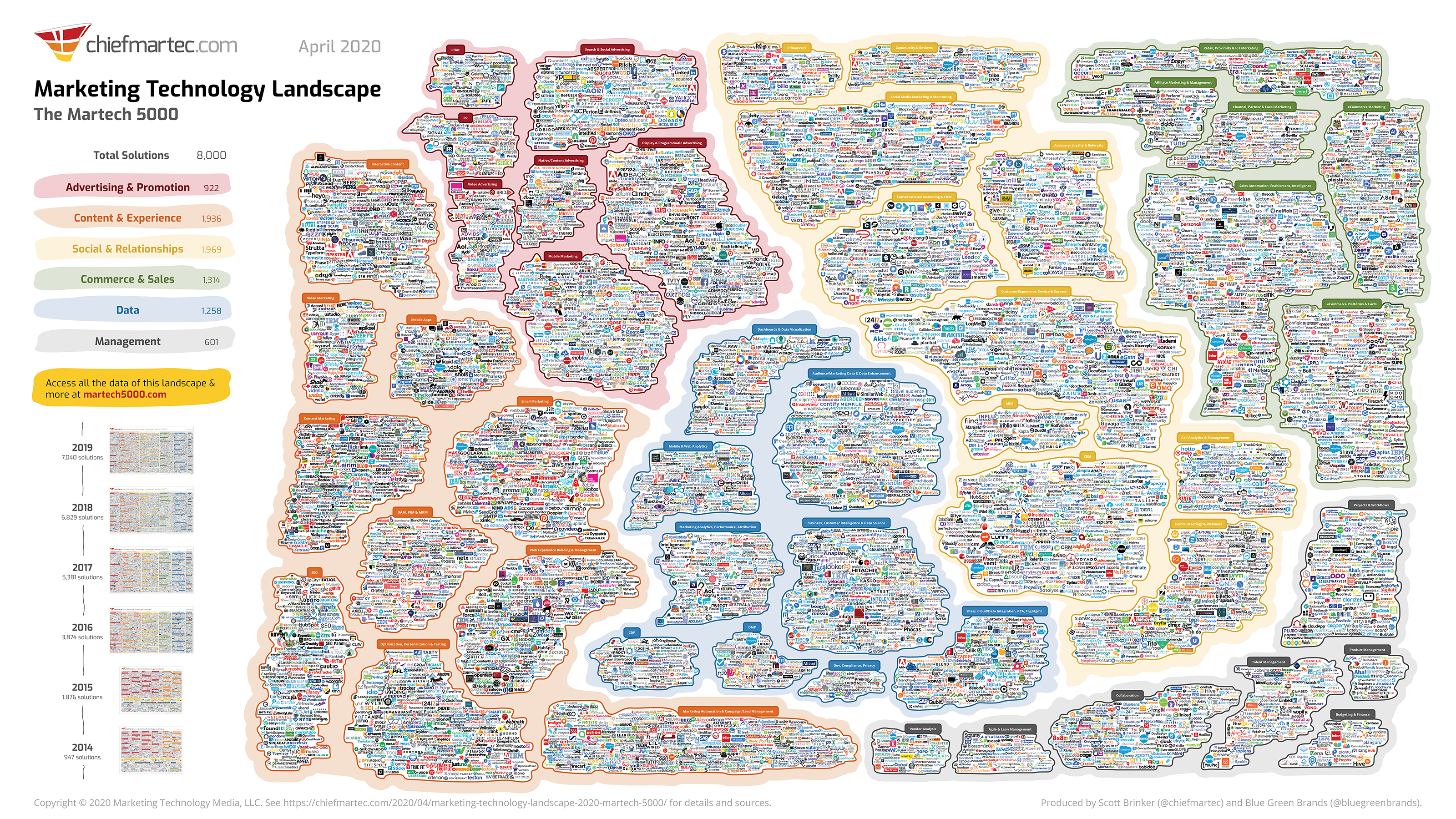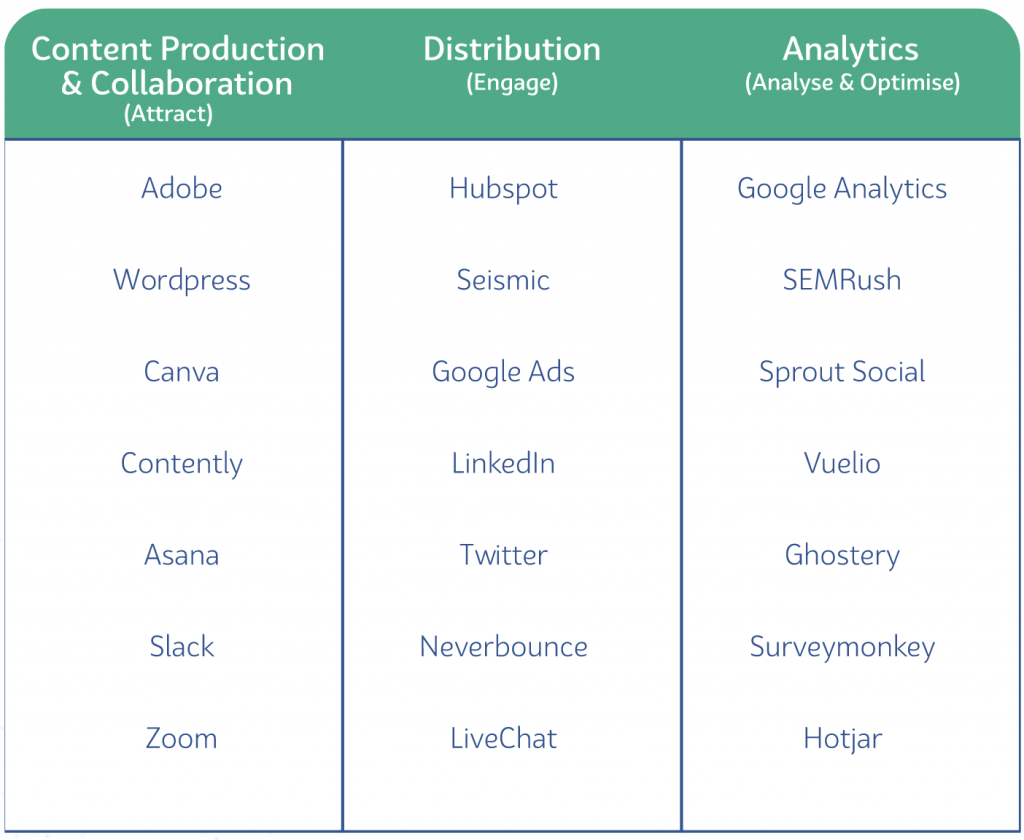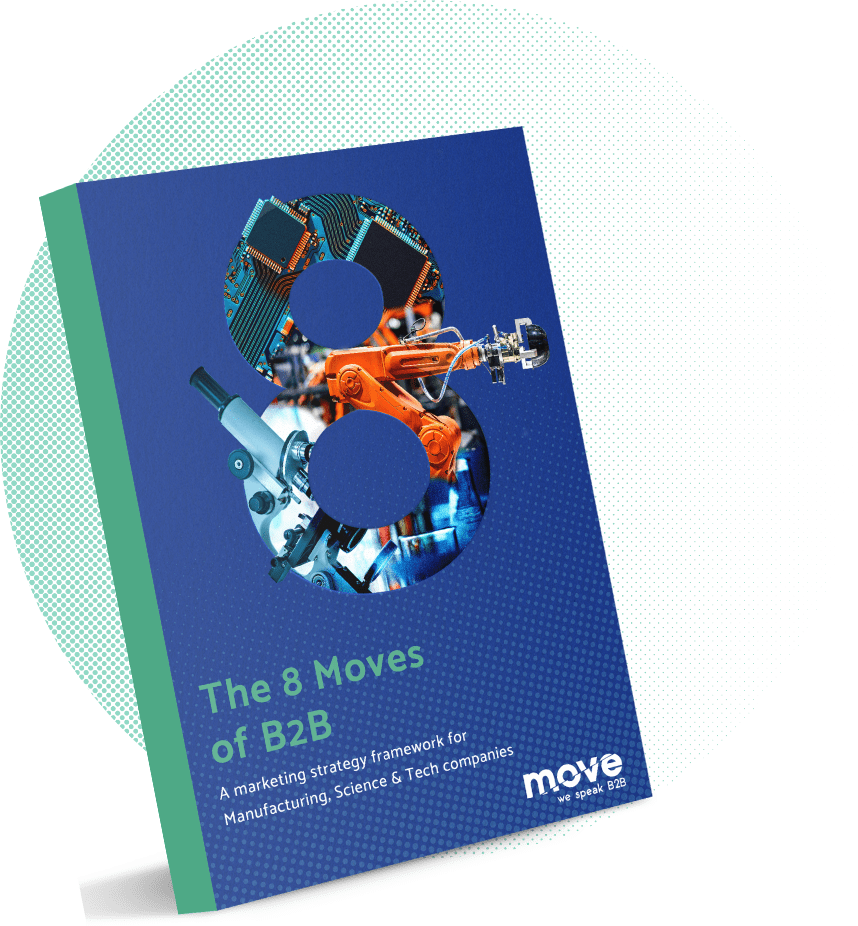
How to build theoptimal B2B MarTech Stack
Move 5: MarTech Stack
In recent years, we’ve witnessed the proliferation of a new generation of tools for producing, delivering and evaluating the engagement and success levels of marketing content. At its most basic level, a Marketing Technology (MarTech) Stack is a collection of technology-based tools used by marketers to help them effectively automate, perform and report on various multi-channel marketing activities across the customer lifecycle. The combination of tools can vary depending on type and size of business, budget and the company’s strategic goals and priorities. At its most advanced level it can be a major source of competitive marketing advantage.
The internet has levelled the playing field for industrial and B2B SMEs in recent years and the media landscape is certainly changing as a re-sult of this. In the present day, access to audiences has been ceded to platforms. Publishers’ old value proposition to brands — which was essentially access to the audiences — is now beginning to dissipate with the advent of social platforms with massive user bases, not to mention a raft of popular digital publishers sprawled across the internet and thousands of MarTech Stack platforms. These emerging forces have begun to disrupt legacy publishers’ control over audiences.
Despite that, it’s worth remembering that the internet and MarTech as a whole are ultimately still just tools, they’re not necessarily the answer on their own. A tool is not a strategy. There are no silver bullet solutions. Think of MarTech more as an enabler for executing strategy. The internet age and the associated flood of information and data that comes with it has actually served to increase the importance of good strategic planning. A clearly defined strategy now represents the best way to cut through the noise of the thousands of different channel and platform options and data points available and hone in on the optimal channel mix. Consequently, whatever tools you choose for your MarTech stack, just remember that the technology you choose must also connect into your strategy, not the other way around.
The latest Gartner Marketing Technology Survey findings reveal that marketing leaders report utilizing only 58% of their MarTech stack’s potential. That’s despite now spending 26% of their marketing budgets on MarTech.17 The average marketing stack consists of as many as 17 or more tools.18 However, most modern marketers are more concerned with finding integrations to cross-reference existing data points than they are with adding more to the stack. The tools are out there but the challenge of how best to construct an appropriate B2B MarTech stack for your organisation has become one of the most critical in the modern strategic planning equation
5.1. Steps to consider in building the optimal B2B MarTech Stack
Many will already be familiar with the Marketing Technology Landscape graphic (MarTech 8000) produced by Scott Brinker of chiefmartec.com on an annual basis. It’s said to be one of the most frequently shared slides of all time.
This chart is pretty intimidating for a B2C marketer, let alone a B2B marketer! But by breaking down the overall marketing stack into chunks it’s possible to arrive at a more manageable process for building your own B2B marketing tech stack. There are a few key imperatives in this respect; (a) there are six core groupings (advertising & promotion, content & experience, social & relationships, commerce & sales, data and
management) split down into forty-nine sub-categories – many will not be required at all so refine the list down to those areas that you are sure will be applicable; (b) don’t be afraid of a trial and error process to your evolving tech stack. Once you have defined a suite of, say, ten or fifteen tools don’t just assume that the project is complete and move on to something else. Revisit, re-evaluate and consistently test (most tools have free trials or demos) and swap new tools in and out to refine your suite of tools into the most agile, smart, connected and efficient tech stack possible; (c) consider how your tech stack can be angled and tailored in a way that provides better personalised content for your prospects and customers.

I recently undertook the strategic planning process for the European division of a major global manufacturer of IT equipment for specialist applications including healthcare, business enterprise, operating theatres and industrial. Brand evaluation was the key driver for the project as the company was competing against household names amongst other brands and one of the primary conclusions was that, by using MarTech in a smart way, we could achieve much better results in terms of brand consistency and reinforcement going forwards. For example, the brand had been sending a series of disjointed and mixed messages to the market, partly as a result of salespeople and distributors hashing together their own marketing presentations and support packs. At the front end we helped implement a sales enablement tool which has since acted as a brand platform to control brand exposure and, at the same time, at the back end we installed a defined set of monitoring tools to track digital brand mentions, social engagement and SEO performance.
According to the State of Marketing Technology 2018 report, 69% of respondents believed “the perfect marketing stack does not exist yet.” This is unsurprising as the “perfect stack” will never exist. With an expanded range of more than 8000 tools, there is no one size fits all approach when it comes to B2B MarTech. Every company must construct a solution that fits the specific needs of its business.
With an expanded range of more than 8000 tools, there is no one size fits all approach when it comes to B2B MarTech
It’s best to keep things as straightforward as possible at the outset of defining your MarTech stack, whether this is a first look at this or evaluation of an existing baseline. As such I’ve developed a stripped back framework for B2B SMEs which focuses on just three wider core areas (Content Production & Collaboration, Distribution and Analytics). The chart below shows an example of what a limited suite of tools across each category would look like. With the exception of Hubspot, Seismic and Vuelio (these each represent bigger ticket subscriptions in excess of £500 per month) which are perhaps more aspirational, this represents a fairly comprehensive
MarTech stack for a forward thinking SME B2B company in the £10 – £30 million turnover bracket. This particular example comprises a balanced mix of 21 tools, four above the industry average. A typical MarTech stack takes a CRM solution or Automation platform (Hubspot in this example) as the base component and then bolts on a number of component tools within the following broader categories:
Example B2B Martech Stack

Rather than obsessing too much over specific branded tools though, it’s better to approach your MarTech stack framework with some more straightforward questions:
- What does my company’s current MarTech stack look like?
- Are these technologies internal or external facing?
- What am I trying to achieve in terms of content production?
- What collaboration will be needed to fulfil these requirements?
- How will I disseminate this content to the key target groups?
- How can I measure content engagement and impact?
- Where are the priorities in terms of evolving the stack?
- Can I connect, integrate and share data between the different tools?
- Does the newly defined tech stack align
- with the strategy and meet marketing goals?
The strategic planning process for another client of mine operating in the heavy engineering sector needed a long-term vision and dashboard on an array of drip-feed content activities. We drew together a suite of MarTech monitoring tools across digital PR, social, automated email, organic web traffic and paid search to help track key benchmarks and identify areas for tactical improvements. Essentially, this helped align the strategy and tactics with measured/ quantifiable benchmarks and ultimate effectiveness.
The Ultimate B2B Marketing Guide

